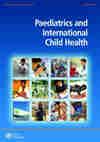链球菌感染后并发快速进行性肾小球肾炎和急性风湿热1例
IF 1.4
4区 医学
Q3 PEDIATRICS
引用次数: 0
摘要
摘要急性链球菌后肾小球肾炎(APSGN)和急性风湿热(ARF)是A组链球菌(GAS)感染后常见的免疫介导并发症。对于APSGN和ARF,GAS上的致病抗原表位是不同的,并且它们同时发生是罕见的。一名12岁男孩出现发烧和严重血尿。他双脚背有皮下结节,尖端有新的全收缩杂音,入院后出现高血压和全身水肿。研究证实了APSGN对ARF的诊断。他接受了皮质类固醇来控制这两种情况的炎症。他的临床症状逐渐好转,但他仍然患有风湿性心脏病。由于这两种疾病都可能发生在同一名患者身上,因此应为这两种情况提供治疗。缩写:APSGN:急性链球菌性肾小球肾炎;ARF:急性风湿热;ASO:抗链球菌溶素O;Cr:血清肌酐;CRP:C反应蛋白;ESR:红细胞沉降率;GAS:A组链球菌;RBC:红细胞;RPGN:快速进行性肾小球肾炎;S1:第一心音;S2:第二心音;TTE:经胸超声心动图。本文章由计算机程序翻译,如有差异,请以英文原文为准。
Concomitant rapidly progressive glomerulonephritis and acute rheumatic fever after streptococcus infection: a case report
ABSTRACT Acute post-streptococcal glomerulonephritis (APSGN) and acute rheumatic fever (ARF) are common immune-mediated complications after group A streptococcus (GAS) infection. The causative antigenic epitopes on GAS are different for APSGN and ARF, and their simultaneous occurrence is uncommon. A 12-year-old boy presented with fever and gross haematuria. He had subcutaneous nodules on the dorsum of both feet along with a new holosystolic murmur at the apex, and he developed hypertension and generalised oedema after admission. Investigation confirmed the diagnosis of ARF with APSGN. He received a corticosteroid to control inflammation of both the conditions. His clinical signs gradually improved but he still had rheumatic heart disease. As both diseases can occur in the same patient, treatment should be provided for both conditions. Abbreviations: APSGN: acute post-streptococcal glomerulonephritis; ARF: acute rheumatic fever; ASO: antistreptolysin O; Cr: serum creatinine; CRP: C-reactive protein; ESR: erythrocyte sedimentation rate; GAS: group A streptococcus; RBC: red blood cells; RPGN: rapidly progressive glomerulonephritis; S1: first heart sound; S2: second heart sound; TTE: transthoracic echocardiogram.
求助全文
通过发布文献求助,成功后即可免费获取论文全文。
去求助
来源期刊

Paediatrics and International Child Health
PEDIATRICS-
CiteScore
3.30
自引率
0.00%
发文量
19
审稿时长
6-12 weeks
期刊介绍:
Paediatrics and International Child Health is an international forum for all aspects of paediatrics and child health in developing and low-income countries. The international, peer-reviewed papers cover a wide range of diseases in childhood and examine the social and cultural settings in which they occur. Although the main aim is to enable authors in developing and low-income countries to publish internationally, it also accepts relevant papers from industrialised countries. The journal is a key publication for all with an interest in paediatric health in low-resource settings.
 求助内容:
求助内容: 应助结果提醒方式:
应助结果提醒方式:


